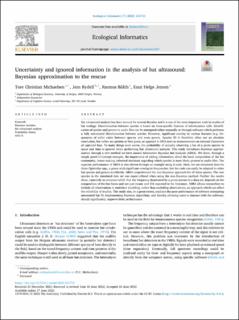| dc.description.abstract | Bat ultrasound analysis has been around for several decades and it is one of the most important tools in studies of bat ecology. Discrimination between species is based on intra-specific features of echolocation calls. Identification of species and genera in audio files can be attempted either manually or through software which performs a fully automated discrimination between species. However, significant overlap in various features (e.g. frequencies of calls) exists between species and even genera. Species ID is therefore often not an absolute conclusion, but rather an opinion or best guess, as opposed to DNA tests or measurements on external characters of captured bats. To make things even worse, the probability of actually observing a bat of a given species in space and time is ignored when performing bat ultrasound analysis. This study introduces Bayesian approximation through a new method we have named Alternative Bayesian Bat Analysis (ABBA). We show, through a simple proof-of-concept example, the importance of adding information about the local composition of the bat community, hence making informed decisions regarding which species is most likely present in audio files. The superior performance of ABBA is also shown through an example using R code. Here, we use simulated data for three Pipistrellus spp., a genus with significant overlap in frequencies, but the code can easily be adapted to other bat species and genera worldwide. ABBA outperformed the non-Bayesian approach for all three species. The rare species in the simulated data set was super-inflated when using the non-Bayesian method. Further the results show, contrarily to common belief, that the frequency dominated by a given species in a data set, depends on the composition of the bat fauna and not just means and SDs reported in the literature. ABBA allows researchers to include all observations in statistical modeling, rather than excluding observations, an approach which can affect the reliability of studies. This study also, to a great extent, explains the poor performance of software attempting automated bat ID. Implementing Bayesian algorithms, and thereby allowing users to interact with the software, should significantly improve their performance. | en_US |

